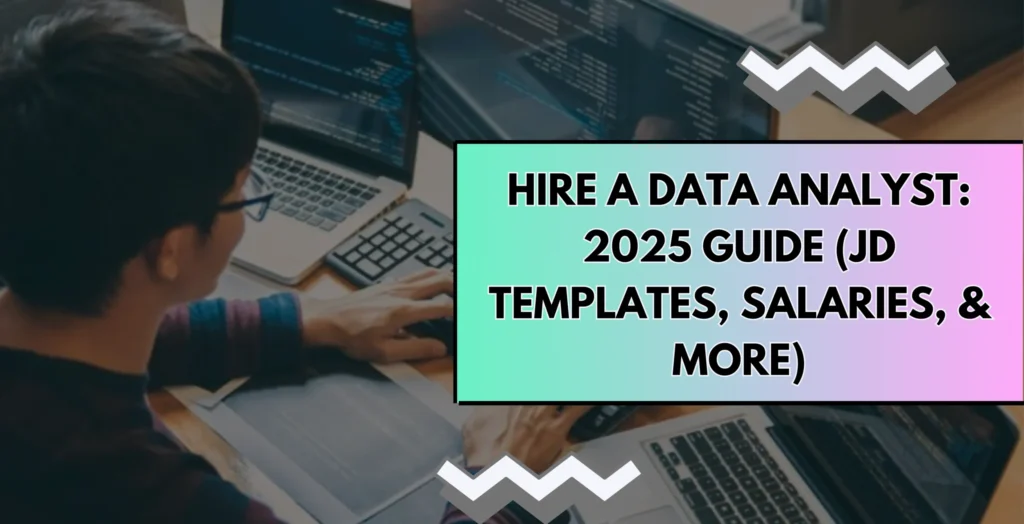Key Takeaways
- Hiring a data analyst in-house takes time, costs $90K+ per year, and requires tools, onboarding, and internal oversight.
- Analytics vendors offer faster results, niche expertise, and lower upfront costs but often lock you into long-term retainers or bundles.
- The best data analytics companies in 2025 like Talent Hackers, SAS, IQVIA, and Civis Analytics, serve enterprises with deep, industry-specific needs.
- Vendors are ideal when you need quick project turnaround, advanced analytics (e.g., ML models, clinical data, risk modeling) and flexible staffing without headcount
- In-house is better for long-term, embedded analytics functions where control and institutional knowledge matter.
Talent Hackers gives you pre-vetted analysts ready to start in 3-5 days, and transparent offshore rates
You know you need analytics help but building an in-house team isn’t always the smart first move.
Hiring a full-time data analyst today is costly, time-consuming, and resource-heavy. Between sourcing, interviewing, onboarding, and training, you could be looking at 8–12 weeks before you see results, and that’s if you find the right candidate. Add in the salary (often $90K+ annually in the U.S.) plus tooling, compliance, and benefits, and suddenly a “simple hire” becomes a full-scale operation.
For companies under pressure to move fast or teams that just need short-term support, hiring a data analytics vendor is often the better call. The right vendor brings pre-built infrastructure, domain expertise, and on-demand analysts who can plug into your project within days. It’s scalable, flexible, and frequently 50–60% more cost-effective than hiring locally.
In this guide, we’ll break down:
- When it makes sense to go with a vendor vs. hiring in-house
- What to look for in a data analytics company (and what to avoid)
- 6 top-rated analytics vendors to consider in 2025
- How platforms like Talent Hackers give you the best of both worlds—speed, flexibility, and pre-vetted talent without the cost or complexity of big vendors
If you’re trying to decide between hiring a data analyst or bringing in external support, this is your roadmap.
Here’s a complete guide of all you need to know about hiring a data analyst.
Why Companies Choose Data Analytics Companies Over Hiring Analysts
Hiring a full-time analyst isn’t always the right first step—especially when speed, scalability, or specialized skills are the priority. That’s why more companies are choosing data analytics companies over building in-house teams from day one.
1. Immediate Expertise, No Recruiting Lag
When you need dashboards built, data cleaned, or insights delivered yesterday, waiting 8–12 weeks to hire an analyst isn’t realistic. Analytics vendors come with plug-and-play talent—teams that already know the tools, the frameworks, and how to deliver value fast.
According to Valiotti, hiring an in-house team of just three (Data Analyst, Data Engineer, HR) can cost over $94,000 in six months. Outsourcing the same capabilities? Roughly $40,000—a 60% savings, with results delivered twice as fast.
2. Scale & Flexibility on Demand
Need two analysts next week? Zero the month after? Vendors let you ramp up or down based on actual business needs—without long-term hiring commitments, onboarding costs, or seat licenses you don’t use.
This agility is especially valuable for:
- Early-stage startups testing MVPs
- Marketing teams running seasonal campaigns
- Product teams needing sprint-based analytics support
3. Cost vs. Control Trade-off
Hiring a vendor almost always saves money—but there’s a trade-off. You lose some day-to-day control, and not all vendors are created equal. The wrong one might under-deliver, overcharge, or fail to understand your business context. That’s why choosing the right analytics partner—with vetted talent, clear pricing, and aligned goals—is critical.
4. Outside Perspective Can Be a Shortcut to Better Results
Top analytics companies don’t just execute—they advise. They’ve worked across industries and tool stacks, and often bring frameworks, dashboards, or governance models you wouldn’t build from scratch internally.
Sources like Forte Group, HashStudioz, and DeMar Consulting all agree: bringing in outside data experts often accelerates implementation, quality, and ROI.
5. Or You Can Blend Both: Hybrid Models Work
Some companies start with a vendor to move fast, then build internal analytics capabilities in parallel. Others keep a lean in-house team for core metrics and supplement with vendor support for complex projects.
Even Wikipedia lists hybrid analytics strategies as the new norm—especially as data stacks grow more fragmented and project-based.
The 7 Leading Data Analytics Companies to Consider in 2025
If you’re exploring data analyst companies in 2025, you’re likely facing a key decision: Should you build a team in-house or bring in a vendor to fill the gap?
The companies below are leaders in analytics delivery, offering everything from strategic advisory to data science implementation. But each comes with trade-offs. Let’s break down who they serve, where they shine, and when Talent Hackers might be the smarter fit.
1. Talent Hackers
- Who they serve: Growth-stage companies and enterprise teams across North America, LATAM, Europe, and APAC—looking for vetted offshore or nearshore data analysts.
- Core strength: Matches you with pre-vetted analysts in 48 hours, with transparent country-by-country rates and no vendor markup.
- Limitation: Built for execution—best when you already know what you need, not for strategic consulting.
- Best for: Startups, marketing teams, and fast-scaling ops teams that need results—not retainers.
- How it compares: Unlike traditional data analytics companies, Talent Hackers offers the control of in-house hiring with the speed of vendor delivery—without the complexity or cost of enterprise consulting.
👉 Hire Data Analysts in 48 Hours
2. SAS Institute
- Who they serve: Fortune 500 clients, especially in insurance, pharmaceuticals, and financial services.
- Core strength: Enterprise-grade analytics platforms backed by consulting arms. Offers advanced tools for predictive modeling, risk analysis, and BI at scale.
- Limitation: High implementation costs, steep learning curve, and long deployment timelines.
- Best for: Large enterprises needing both analytics infrastructure and expert services.
- How Talent Hackers differs: Where SAS brings power, Talent Hackers brings agility and access—ideal for companies that want analysts working within their existing stack.
3. Civis Analytics
- Who they serve: Large U.S.-based companies (clients include Airbnb, Verizon), nonprofits, and public sector orgs.
- Core strength: Data science consulting + proprietary tooling focused on audience modeling and survey analytics.
- Limitation: U.S.-centric focus, smaller teams, and longer onboarding.
- Best for: Enterprises looking for a data strategy partner, not just analysts.
- How Talent Hackers differs: Civis builds strategy—Talent Hackers delivers ready-to-work analysts in days. Ideal if your team already knows what to measure, but needs hands-on help fast.
4. Verisk Analytics
- Who they serve: Insurance, energy, and risk management sectors globally.
- Core strength: Access to proprietary domain datasets and predictive risk models.
- Limitation: Strong vertical focus—less adaptable outside core industries.
- Best for: Companies needing sector-specific analytics + risk modeling baked in.
- How Talent Hackers differs: Talent Hackers is tool-agnostic and industry-flexible, helping clients fill specific roles in healthcare, retail, SaaS, and beyond.
5. IQVIA
- Who they serve: Healthcare and life sciences leaders (biotech, pharma, medtech).
- Core strength: Massive healthcare datasets, AI modeling, and real-world evidence generation.
- Limitation: Very high cost, with a focus exclusively on healthcare.
- Best for: Clinical research orgs or pharma brands needing deep domain expertise.
- How Talent Hackers differs: For orgs outside pharma—or those needing support on internal analytics initiatives—Talent Hackers offers more flexibility and speed at a fraction of the cost.
6. Rosslyn Data Technologies
- Who they serve: Procurement teams across mid-sized and enterprise organizations.
- Core strength: Specialized in spend analytics and supplier data intelligence.
- Limitation: Narrow use case—best for procurement or supply chain.
- Best for: CFOs and procurement leads optimizing vendor and sourcing strategies.
- How Talent Hackers differs: If your analytics needs go beyond procurement, Talent Hackers gives you access to analysts who can flex across marketing, finance, ops, and product teams.
7. Alpine Data Labs
- Who they serve: Tech-driven companies running Hadoop or big data environments.
- Core strength: Visual/no-code workflows for data science—aimed at business users.
- Limitation: Product is technology-dependent and lacks advisory services.
- Best for: Companies with strong IT/data engineering teams looking to enable business analysts.
- How Talent Hackers differs: Alpine sells tooling. Talent Hackers provides the people to run the tools you already use—SQL, Power BI, Tableau, dbt, and more.
Key Takeaway
Most top data analytics companies serve enterprise clients with niche or strategic needs. But if you’re looking for fast, affordable execution from analysts who plug into your current workflows, Talent Hackers offers the best of both worlds. No software licenses. No six-month onboarding. Just pre-vetted analysts, ready to work.
When to Use a Vendor vs. Hiring an In‑House Analyst
Choosing between a data analytics company and hiring your own analyst depends on urgency, budget, and long-term goals. Here’s how to decide which route fits best:
| Scenario | Vendor (Analytics Company) | In-House Data Analyst |
|---|---|---|
| Time-to-value | Ideal when you need to move fast, vendors have ready teams and tools | Slower recruiting, onboarding, and training can take 2–3 months |
| Budget Flexibility | Better for limited or variable budgets, pay per project or outcome | Higher fixed cost—salary, benefits, tooling, and retention costs |
| Project Type | Great for niche or advanced work (ML, health data, forecasting models) | Strong fit for ongoing, embedded analytics like product dashboards or sales ops |
| IP & Data Control | More risk—data is handled by a third party (needs vetting & contracts) | Full control—your team owns the insights and governance end-to-end |
| Scalability | Vendors let you scale up/down with demand | Scaling = more hires, more overhead |
| Long-Term Fit | Best for short bursts, proof of concepts, or gap-filling | Best for companies with a mature or growing analytics culture |
What About Hybrid Models?
Many companies today use both. You might start with a vendor to launch quickly, then build your in-house team while maintaining vendor support for overflow or specialized work.
According to Forte Group, hybrid approaches are becoming the default for modern teams.
So, Where Does Talent Hackers Fit?
Right in the middle.
Talent Hackers gives you the speed and flexibility of a vendor—with the control and continuity of an in-house hire. You get pre-vetted data analysts matched in 48 hours, transparent rates, and no lock-in contracts. It’s the fastest way to scale smart—without overcommitting or overpaying.
👉 Hire Data Analysts in 48 Hours
Talent Hackers vs. Traditional Analytics Vendors
If you’re weighing data analytics companies against modern hiring alternatives, here’s how Talent Hackers stacks up on the key dimensions that matter:
| Category | Traditional Analytics Vendors | Talent Hackers |
|---|---|---|
|
Weeks to onboard and scope a project | Matches in 48 hours with ready-to-work analysts |
|
Retainers, bundled consulting fees, software licensing | Transparent country-by-country rates, no markups or hidden fees |
|
Depends on vendor team availability and role focus | Pre-vetted data analysts across LATAM, Eastern Europe, Asia, and Africa |
|
Fixed timelines, contracts, and change orders | Scale up or down easily—no long-term commitments |
|
Often priced and structured for enterprise clients | Accessible to startups, growth-stage teams, and mid-market ops |
|
Ideal for advisory-heavy, complex engagements | Ideal for execution-driven, day-to-day analytics support |
Make Your Decision with Confidence
Vendors give you frameworks. Talent Hackers gives you people who can build, ship, and optimize right now—without enterprise overhead or vendor lock-in.
Frequently Asked Questions
-
What counts as a “data analytics company
A data analytics company provides services that help businesses collect, process, and analyze data to generate insights. These companies may offer strategic consulting, dashboard development, data engineering, or advanced analytics like machine learning. They often operate on a project basis or through ongoing retainers. Examples include enterprise vendors like SAS or IQVIA, as well as modern execution-first platforms like Talent Hackers, which match teams with pre-vetted analysts on demand.
-
How much does it cost to hire an analytics vendor vs in-house?
Hiring a full-time data analyst in the U.S. can cost $90,000–$120,000 annually, plus benefits, tools, and onboarding. By contrast, vendors may charge $40,000–$70,000 per project or quarter, depending on scope. However, retainers, bundled services, and long-term contracts can inflate costs quickly. Talent Hackers offers an alternative with transparent country-specific rates and no hidden fees, allowing you to scale support based on real needs.
-
Can vendors work across industries and compliance needs?
Yes, but it depends on the vendor. Enterprise vendors like Verisk (insurance) and IQVIA (healthcare) have deep sector expertise, but are often limited to those verticals. Flexible platforms like Talent Hackers serve multiple industries; marketing, finance, operations by sourcing analysts who are already familiar with your tools, data stack, and compliance expectations.
-
Is hybrid (vendor + in-house) a good long-term model?
Yes, and it’s becoming the norm. Many teams use vendors to start fast or fill skills gaps, then build in-house analytics functions over time. Hybrid models let you balance speed, cost, and control, while avoiding burnout or underinvestment.










